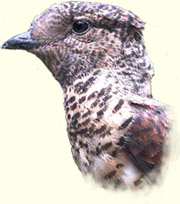|
The
Comores have much to offer as a birding destination: the archipelago
boasts no less than sixteen endemics, including such desirable
species as Comoro Blue Vanga and the monotypic Humblot's
Flycatcher.
Most of the Comoro endemics are forest birds that require a little
effort to find. Grand Comore, with its great diversity of habitat
(ranging from lush forest on the mid-slopes of the 2361m-high Karthala
volcano and forest remants on the northern volcanoes at La Grille,
to alpine heathland surrounding the Karthala crater), offers five
endemics restricted to this island, as well as a further six endemic
to the archipelago. The five Grande Comore endemics, in order of
ease of finding, are Grande Comoro Drongo, Grande Comoro
Brush-Warbler, Humblot's Flycatcher, Karthala White-eye
and Karthala Scops Owl. Endemics that are largely common
and accessible on most of the islands are Comoro Thrush,
Comoro Pigeon, Humblot's Sunbird, Comoro Bulbul,
Comoro Fody and the magnificent Ninga or Comoro
Blue Pigeon.
Mohéli
also posesses a considerable area of untouched forest spanning its
790m ridge, and here a day's hike is almost certain to produce the
superb Comoro Blue Vanga, as well as two further species
restricted to this tiny island: Benson's Brush Warbler and
Comoro Green Pigeon. A fourth endemic, Mohéli
Scops Owl, is predictably harder to find.
Anjouan
offers two further endemics - Anjouan Sunbird and Anjouan
Scops Owl - or even three if its very distinctive thrush is
given species rank. The Sunbird is common even within the grounds
of the airport area, and the second very difficult indeed to see.
Anjouan has suffered considerably from human pressure, although
patches of forest still cling to its spectacularly rugged mountains.
The
most gentle topography of Mayotte is dominated by drier, open woodland
and forest which support the endemic Mayotte Drongo, Mayotte
White-eye and Mayotte Sunbird. Again, all are reasonably
easy to find, the last two even commonly at sea level.
For
birding, October to December are the best months to visit - before
the rains set in in earnest, but when bird activity is still reasonably
high.
Please
see the links on the right for further information about various
aspects of birds, birding and ornithology on the Comores.
Important
Taxonomical Note
Please
note that the taxonomy of many Comorian bird species is often disputed,
and taxa treated as full species by some authors are thought to
be merely sub-species by others. This is partly due to the discrepancies
between current species concepts and the difficulties of testing
the traditional Biological Species Concept in an island context
(please click
here to read an introduction to modern bird taxonomy and
some of the current controversies). Here, when referring to a disputed
species we give trinomials and place the disputed specific name
in parentheses, followed by the disputed sub-specific/specific name.
For example, Kirk's (Madagscascar) White-eye is given as Zosterops
(maderaspatana) kirki.
|
|
 Female
Comoro Cuckoo-Roller,
Female
Comoro Cuckoo-Roller,
Leptosomus discolor
Photo & Sound Gallery
Mouth-watering photos and sound clips of nearly all the Comoro endemic
species and sub-species!
Where
to Watch Birds on the Comores
A detailed online guide to the archipelago's best birding, including
bird abundances at the top sites.
Checklist
of the Birds of the Comores
A complete, annotated checklist, adapted from Louette's standard
work.
Birding
Resources
Listing and online orders of available literature, trip reports
and sound recordings.
NEW! July 2001: Top quality
CD of Comoro bird calls now available.
Ornithological
Literature on the Comores
A comprehensive list of ornithological literature about the Comores.
Text
by
Claire Spottiswoode
& Marc Herremans
Site
Design by
Claire Spottiswoode
of Birding Africa,
Cape Town

|



